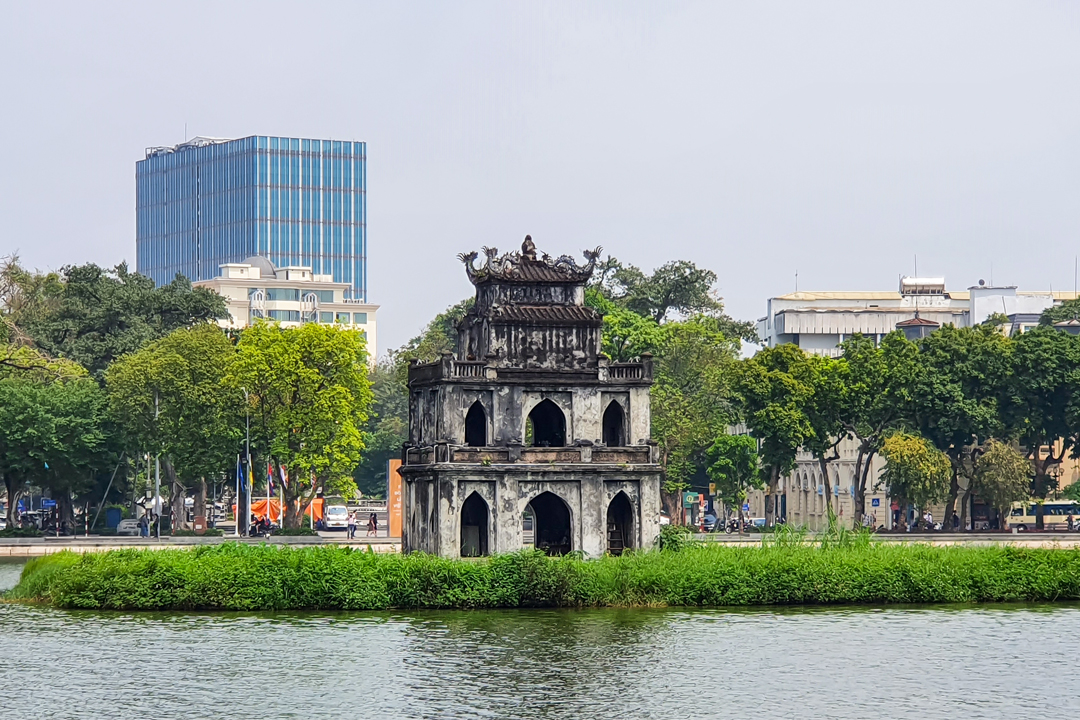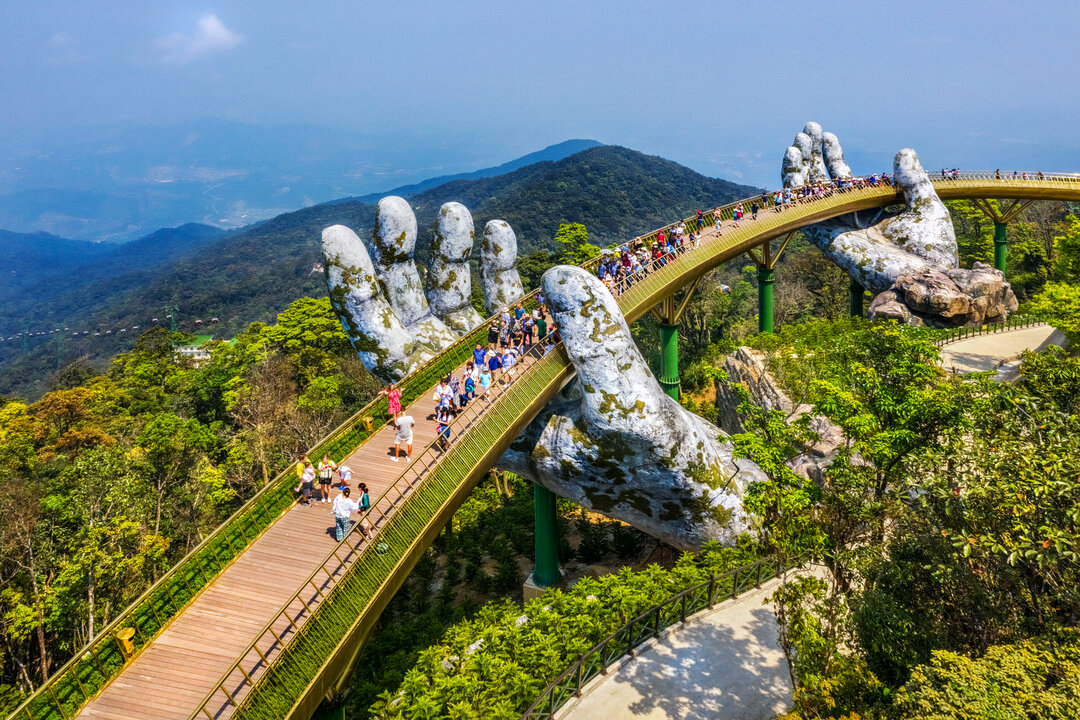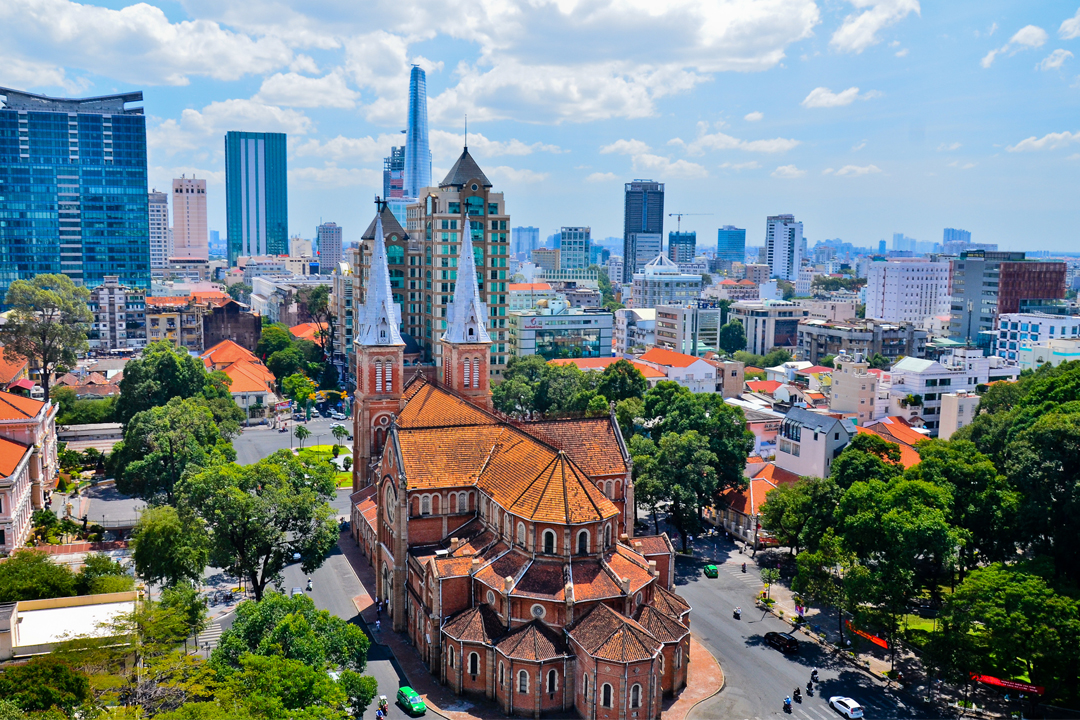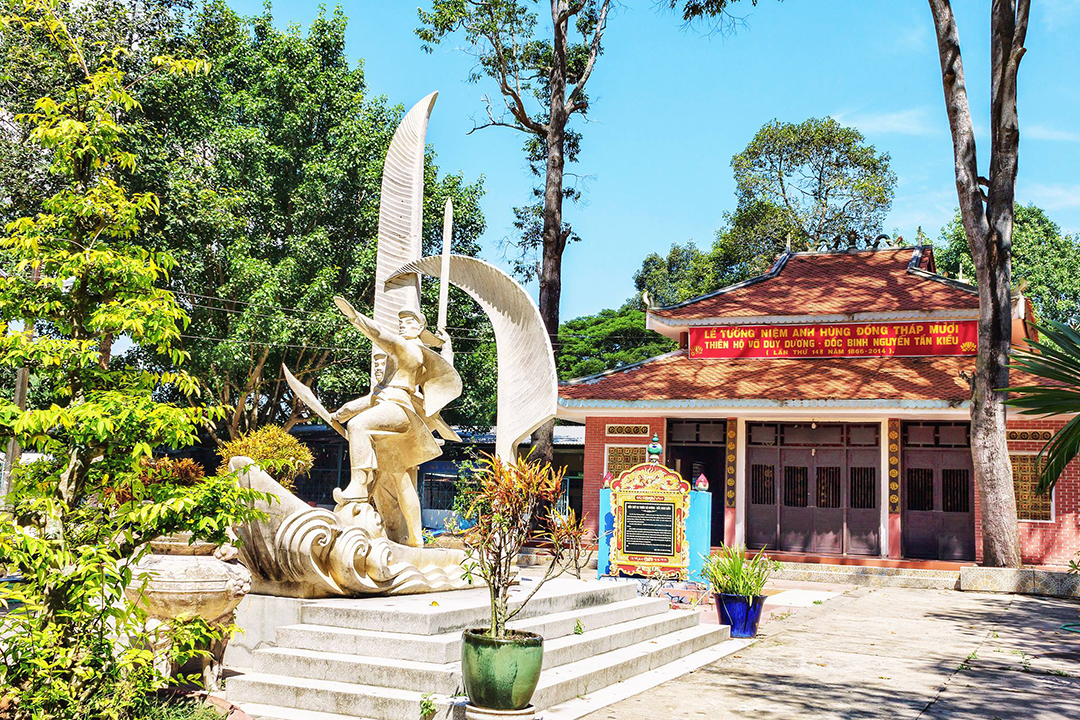Thang Long Imperial Citadel: History, Things To See & Travel Guide
For over a thousand years, Thang Long Imperial Citadel has stood as the heart of Vietnam’s dynastic power, a silent witness to the rise and fall of empires. Located in the historic core of Hanoi, this UNESCO World Heritage Site is a living testament to the nation’s resilience, culture, and architectural brilliance. Built upon the foundations of Dai La Citadel, its evolution spans the Ly, Tran, Le, and Nguyen dynasties, each leaving an indelible mark on its walls, gates, and palatial remnants.
Today, the citadel is a fascinating blend of history and archaeology, where sites like Doan Mon (Main Gate), Kinh Thien Palace, and the Hanoi Flag Tower reveal the grandeur of Vietnam’s imperial past. How have centuries of war, colonization, and preservation shaped this historic landmark? In this in-depth exploration, GTrip uncovers the hidden layers of Thang Long, revealing why it remains one of the most significant heritage sites in Southeast Asia.
After reading through the article, if you want to explore this place and other famous places in Hanoi, please refer to our Hanoi tours.
Overview of Thang Long Imperial Citadel
Location: 19C Hoang Dieu Street, Dien Bien Ward (19C Hoang Dieu Street, Dien Bien Ward, Ba Dinh District, Hanoi)
The Thang Long Imperial Citadel is a remarkable testament to Vietnam’s rich imperial history, standing as a symbol of national identity and cultural heritage for over a millennium. Recognized as a UNESCO World Heritage Site in 2010, the citadel served as the political, cultural, and military heart of Vietnam through various dynasties, including the Ly, Tran, Le, and Nguyen. The Thang Long Imperial Citadel continues to be a site of historical significance, reflecting the nation's resilience and evolution over time.
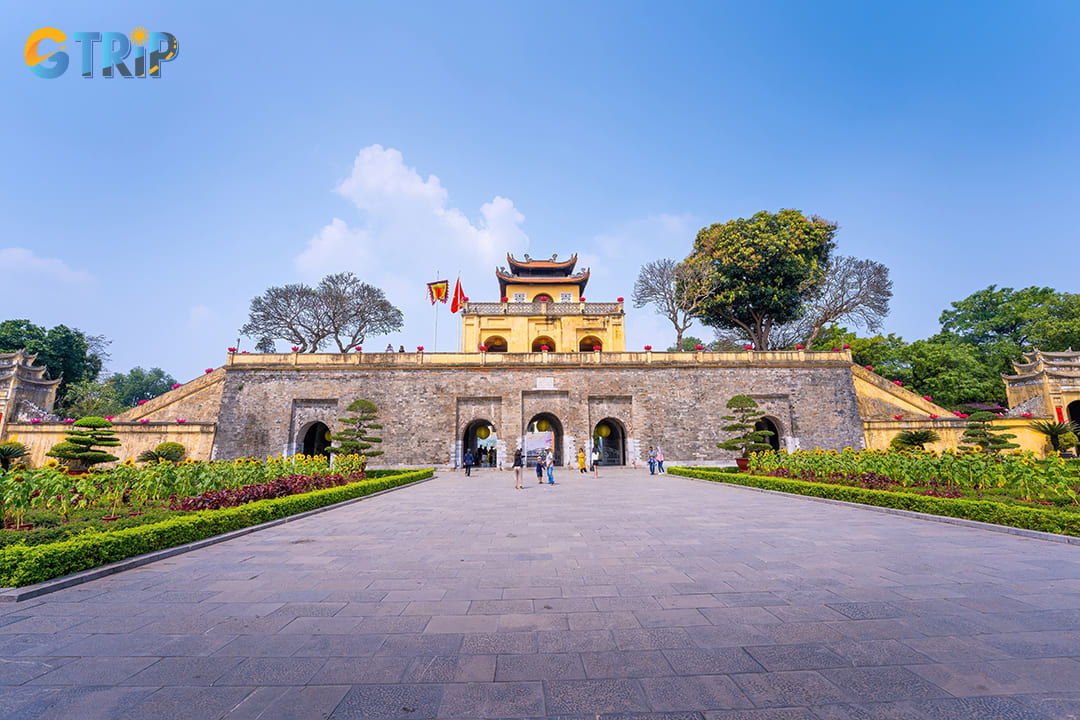
Thang Long Imperial Citadel is a remarkable testament to Vietnam’s rich imperial history
History of the Thang Long Imperial Citadel
The Thang Long Imperial Citadel has a history spanning over a thousand years, reflecting the cultural and political evolution of the country. Its origins date back to 1010 when Emperor Ly Thai To of the Ly Dynasty relocated the capital from Hoa Lu to Dai La, renaming it Thang Long, meaning "Rising Dragon". The citadel, the new capital's political hub, blends Chinese palatial design with Vietnamese elements. Throughout the Ly, Tran, and Le dynasties, the complex underwent expansions, with significant constructions such as royal palaces, temples, and defensive walls.
During the Le Dynasty (1428 - 1789), the citadel continued to flourish as the imperial capital, with major restorations and enhancements. However, its role began to shift when the Nguyen Dynasty (1802 - 1945) moved the capital to Hue in 1802. Despite this transition, Thang Long remained an essential administrative and military hub. Under French colonial rule (1883 - 1954), the citadel suffered extensive destruction, with many ancient structures being demolished to make way for French military establishments. However, remnants of the historic citadel, including foundations of old palaces and ancient roads, were preserved beneath the layers of modern development.
Following Vietnam's independence, the citadel served as a military headquarters, particularly during the resistance against French and American forces. In 2002, large-scale archaeological excavations uncovered invaluable relics from different historical periods, reaffirming the site's immense historical significance. Recognizing its importance, UNESCO designated the Thang Long Imperial Citadel as a World Heritage Site in 2010. Today, it stands as a testament to Vietnam’s rich cultural heritage, offering tourists a glimpse into the nation’s imperial past through its well-preserved artifacts and historical ruins.
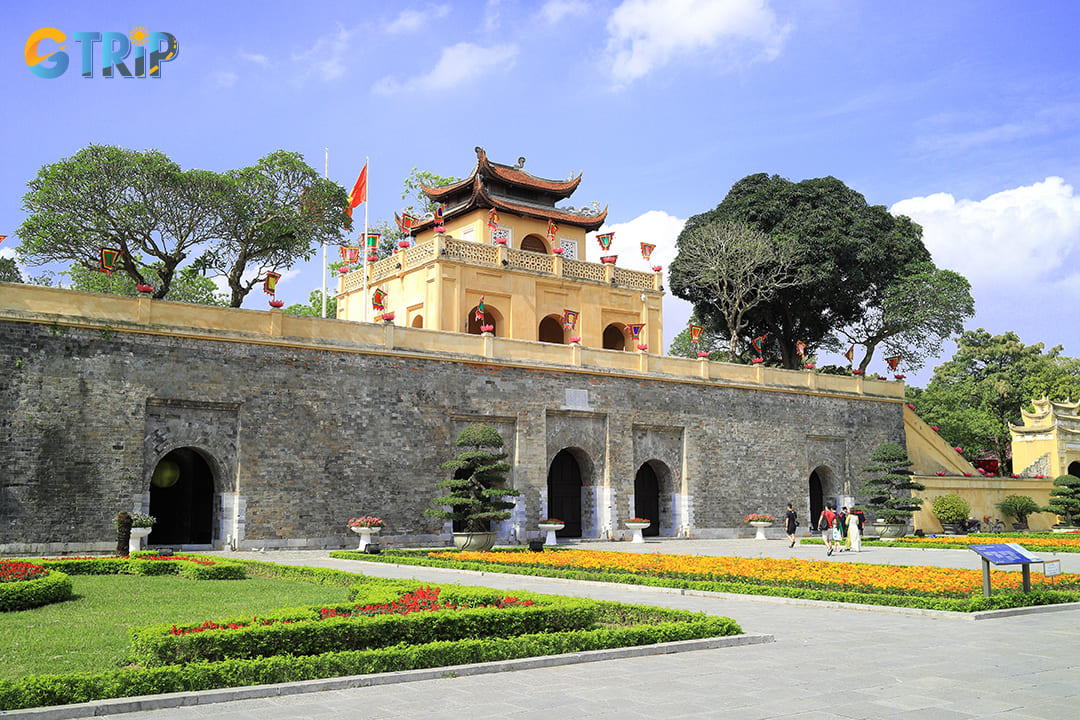
The Thang Long Imperial Citadel has a history spanning over a thousand years, reflecting the cultural and political evolution of the country
Things to see when visiting Thang Long Imperial Citadel
The Imperial Citadel of Thang Long in Hanoi is a treasure trove of Vietnam's rich history and architectural grandeur. As you traverse its expansive grounds, several key landmarks offer profound insights into the nation's imperial past.
Doan Mon Gate
Doan Mon Gate is the main southern entrance to the Forbidden City within the Imperial Citadel of Thang Long, serving as a crucial point of access for emperors and high-ranking officials. Built primarily during the Le dynasty (1428 - 1789), the gate exemplifies traditional Vietnamese fortress architecture, constructed with massive stone blocks to ensure durability and grandeur. The structure features five arched entrances, with the central passageway exclusively reserved for the emperor, while the adjacent openings were designated for members of the royal family and senior mandarins. This hierarchical design reinforced the strict court etiquette and the emperor’s supreme authority within the imperial complex.
Above the gate, a two-story pavilion was later added during the Nguyen dynasty (1802 - 1945), enhancing its architectural significance. This upper section was designed in the style of a watchtower, allowing for both ceremonial functions and defensive purposes. The pavilion was often used as a vantage point for observing royal parades and military inspections. The combination of Le dynasty stonework and Nguyen dynasty modifications showcases the citadel's continuous architectural evolution, reflecting different dynastic influences over centuries.
Beyond Doan Mon, an expansive courtyard historically served as a gathering place for important state ceremonies and royal audiences. The emperors of the Le and early Nguyen periods used this space for official decrees, military processions, and diplomatic receptions. Excavations in the surrounding area have revealed remnants of old pathways and foundations, indicating that this gate was once part of a more extensive network of palatial structures. Today, Doan Mon remains one of the best-preserved sections of the Thang Long Citadel, offering a glimpse into the grandeur and strategic significance of Vietnam’s imperial past.
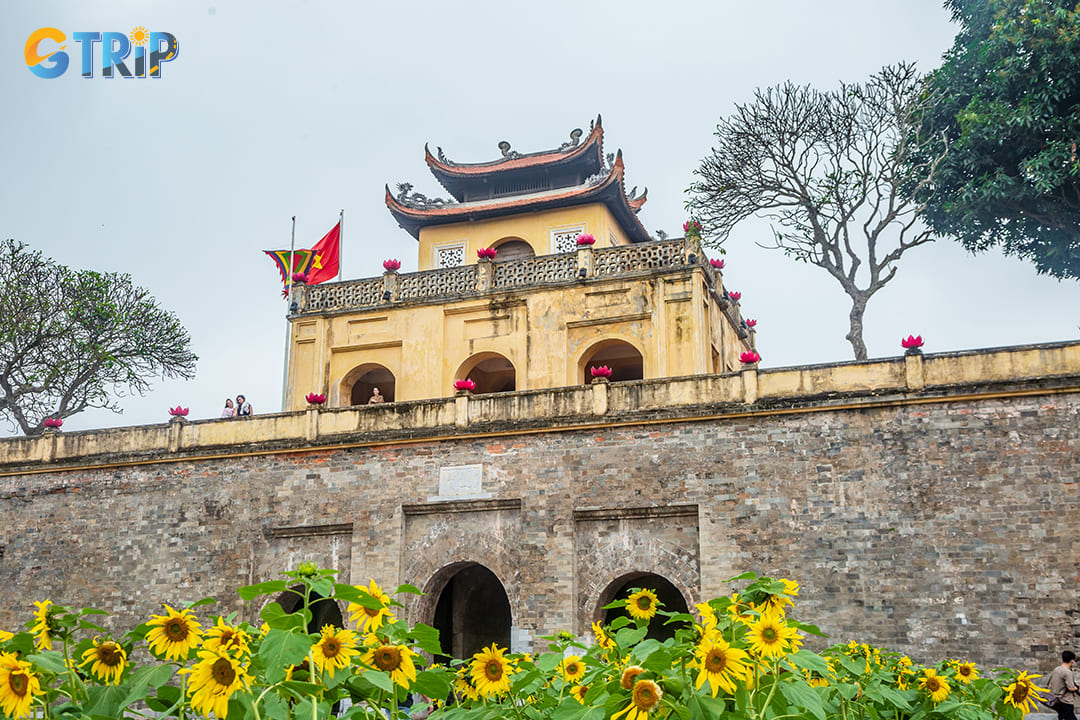
Doan Mon Gate is the main southern entrance to the Forbidden City within the Imperial Citadel of Thang Long
Hanoi Flag Tower
The Hanoi Flag Tower, one of the most iconic historical structures in Vietnam’s capital, stands prominently within the grounds of the Imperial Citadel of Thang Long. Built in 1812 during the reign of Emperor Gia Long of the Nguyen dynasty, the tower was originally constructed as an observation and signaling post for the citadel’s military defenses. Standing at 33.4 meters in height and extending to 41 meters when including the flag, it dominates the skyline of the historic complex. Its base consists of three tiers, constructed with bricks and stone, leading up to an octagonal tower with a spiral staircase inside that makes the tower up to 60m high. The tower’s strategic location on the foundations of the former outer gate of the Forbidden City, dating back to the Le dynasty, highlights its historical continuity as a military and administrative landmark.
Remarkably, the Hanoi Flag Tower survived the destruction that befell much of the Imperial Citadel during the French colonial period. While many structures were demolished to make way for military barracks, the tower was repurposed by the French army as an observation post, demonstrating its enduring military significance. The structure features a cylindrical core with six arched windows and three levels, allowing for effective surveillance of the surrounding area. The tower's uppermost platform supports the flagpole, where the national flag of Vietnam now proudly flies, symbolizing resilience and national pride.
Today, the Hanoi Flag Tower serves as a symbol of Vietnam’s historical endurance, standing as one of the few surviving structures of the once-magnificent Thang Long Citadel. It has been incorporated into the Vietnam Military History Museum, reflecting its deep-rooted connection to the country’s military past. You can ascend part of the structure to admire panoramic views of Hanoi and gain insight into its historical and strategic importance. As a well-preserved monument, the Hanoi Flag Tower remains an enduring testament to Vietnam’s architectural ingenuity and the indomitable spirit of its people.
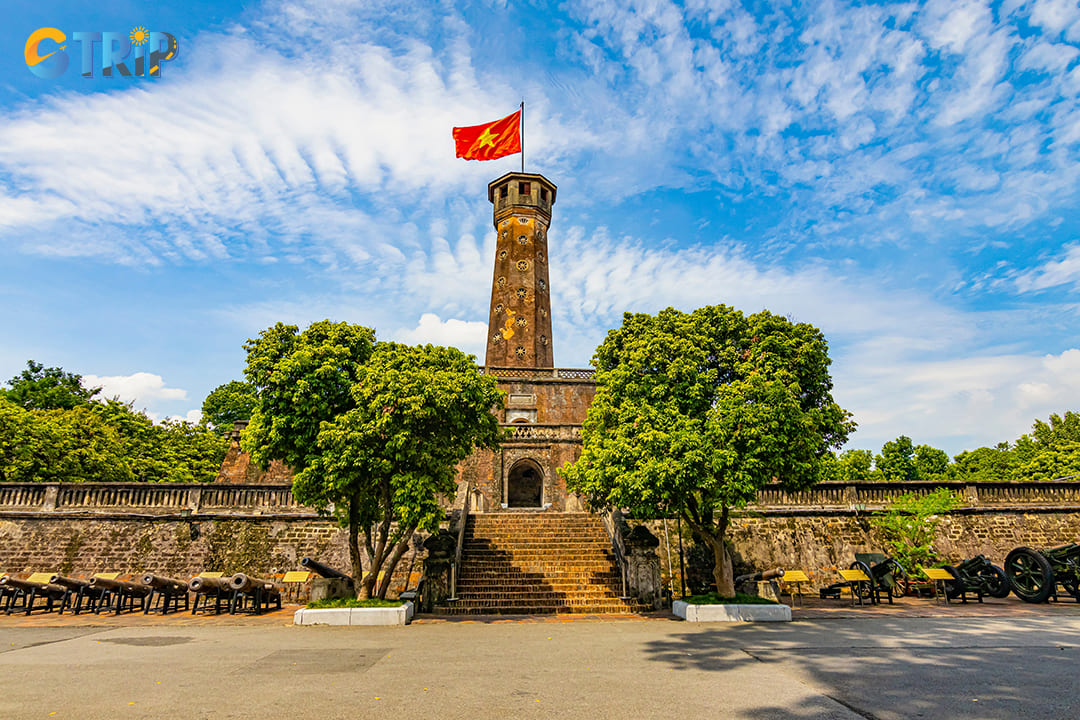
The Hanoi Flag Tower, one of the most iconic historical structures in Vietnam’s capital, stands prominently within the grounds of the Imperial Citadel of Thang Long
Kinh Thien Palace & Dragon Steps
Kinh Thien Palace once stood as the political and spiritual heart of the Thang Long Imperial Citadel, serving as the primary venue for royal ceremonies, state affairs, and diplomatic receptions. Built in 1428 during the reign of Emperor Le Thai To of the early Le dynasty, the palace was an architectural masterpiece that reflected the grandeur of Vietnamese imperial rule. The structure was situated at the center of the citadel, symbolizing the emperor’s supreme authority and the divine mandate he held. Unfortunately, the palace was largely destroyed during the French colonial period, with only its stone foundation and a few remnants surviving. The French repurposed the site, constructing military barracks over the ruins, further erasing traces of its original splendor.
One of the most significant surviving features of Kinh Thien Palace is the Dragon Steps, a grand staircase leading up to what was once the main hall. These steps, dating back to 1467 under Emperor Le Thanh Tong, are adorned with four intricately carved stone dragons, each measuring approximately four meters in length. These dragons, a common imperial motif, symbolize power, wisdom, and the emperor’s divine connection to heaven. Crafted from greenstone, the dragons exhibit exceptional detail, with finely sculpted scales, fierce expressions, and flowing clouds beneath their bodies. Their placement at the center of the citadel reinforces their role in guarding the heart of the imperial complex.
Despite the palace’s destruction, the remnants of Kinh Thien Palace, particularly the Dragon Steps, remain a focal point for historical and cultural research. The site continues to hold ceremonial significance, with official state rituals occasionally conducted there to honor Vietnam’s imperial past. Tourists today can explore the ruins, where information boards and archaeological findings help reconstruct the palace’s former grandeur. The Dragon Steps, in particular, stand as a testament to the artistic excellence and spiritual depth of early Le dynasty architecture.
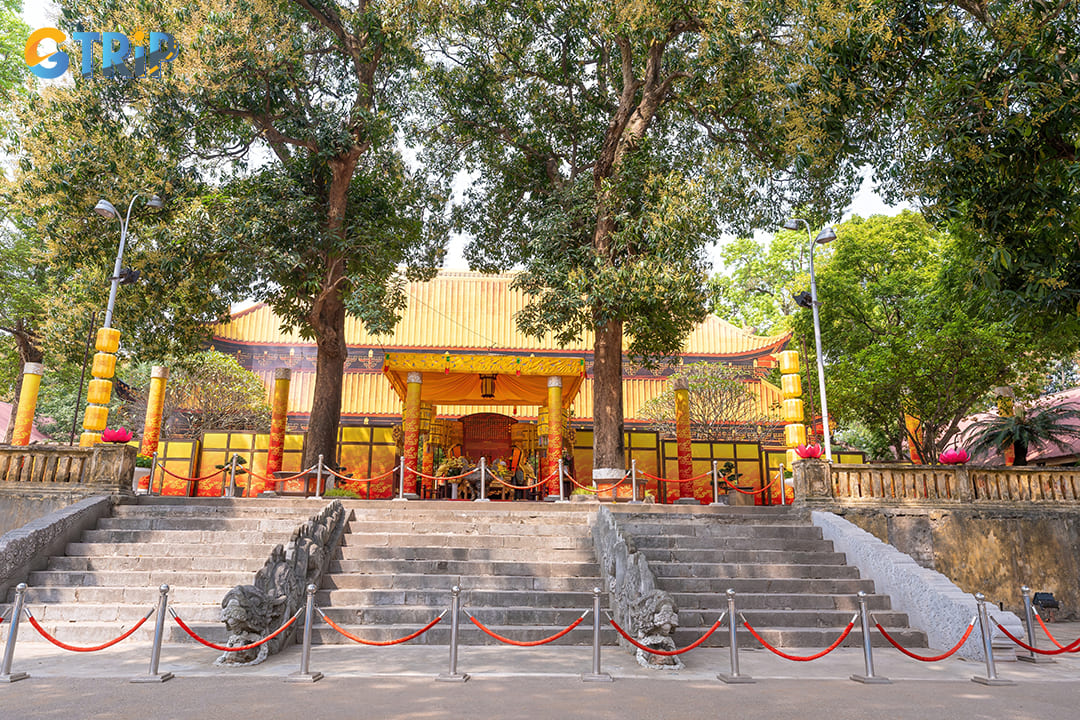
One of the most significant surviving features of Kinh Thien Palace is the Dragon Steps, a grand staircase leading up to what was once the main hall
Hau Lau (Rear Palace)
Hau Lau, also known as the Rear Palace or the Princess' Palace, was an integral part of the Thang Long Imperial Citadel. It historically served as a residence for imperial concubines and female members of the royal family. The name "Hau Lau" translates to "Rear Pavilion" or "Rear Palace" indicating its location within the citadel complex. While the present structure dates back to a later period, historical records and archaeological evidence suggest that the site has been in use since the Ly, Tran, and Le dynasties. Its primary function was to house concubines and provide a secluded, protected space for women of the imperial court, who played significant but often undocumented roles in palace life.
The existing Hau Lau building was reconstructed in the late 19th and early 20th centuries after suffering damage during various conflicts, particularly under French colonial rule. Unlike earlier wooden palace structures that were vulnerable to fire and war, the current version features European-influenced architecture with thick walls and a more durable design. However, excavations in the surrounding area have uncovered remnants of older foundations, ceramic fragments, and decorative architectural elements that date back centuries. These artifacts provide valuable insights into the artistic and cultural influences of different dynasties, reflecting the evolving styles of imperial Vietnam.
Today, Hau Lau stands as a historical landmark within the Thang Long Imperial Citadel complex, offering a rare glimpse into the secluded world of royal women. While much of its original grandeur has been lost, ongoing archaeological research continues to shed light on its past significance. The site remains a crucial part of Vietnam’s heritage, symbolizing the layered history of Thang Long and the enduring legacy of Vietnam’s imperial courts.
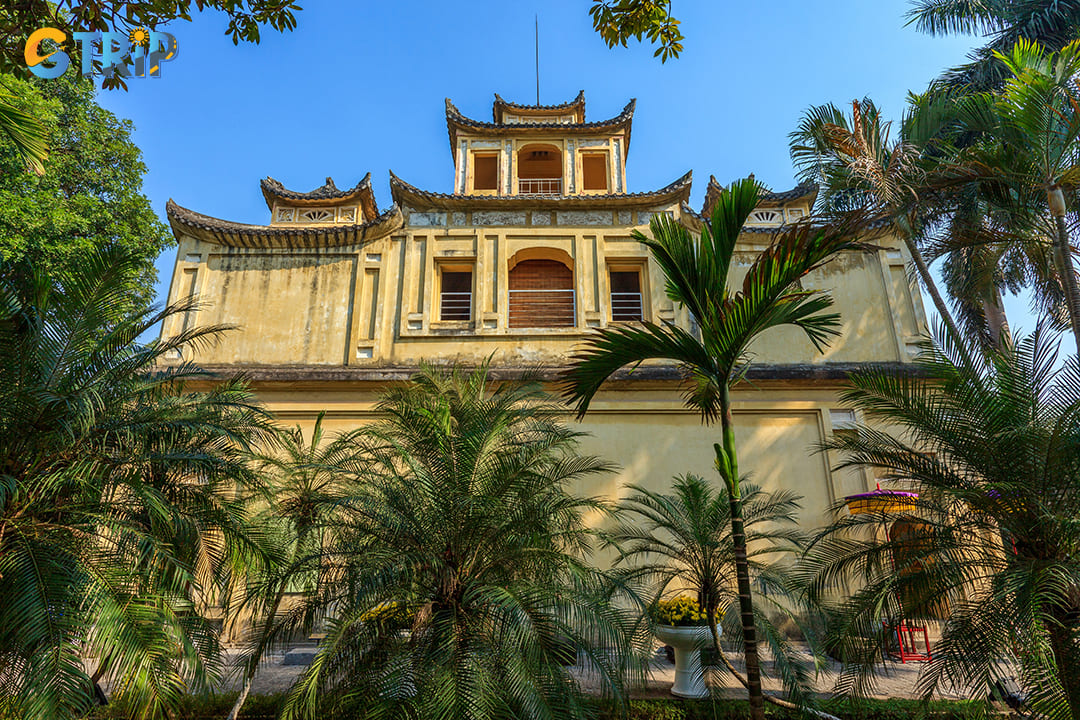
Hau Lau, also known as the Rear Palace or the Princess' Palace historically served as a residence for imperial concubines and female members of the royal family
Artifacts and relics in Thang Long Imperial Citadel
The Thang Long Imperial Citadel is one of Vietnam’s most significant archaeological sites, with its historical depth best demonstrated by the excavations at 18 Hoang Dieu Street. This site reveals over 1,300 years of continuous occupation, with three distinct layers of cultural deposits corresponding to different dynastic periods. The lowest layer, dating back to the Tang dynasty (7th - 9th centuries), is part of the eastern section of the Dai La citadel during the rule of Cao Bien. The middle layer consists of remnants from the Ly and Tran dynasties, showcasing the palatial structures of the time. The uppermost layer reflects the later changes during the Le dynasty and the 19th-century Nguyen dynasty, marking the site’s enduring role as the political and cultural center of Hanoi.
Archaeologists have divided the excavation into four zones, A, B, C, and D, each revealing different aspects of the citadel's past. Among the most significant findings are ceramic and pottery artifacts, illustrating the evolution of Vietnamese craftsmanship and trade. The Ly and Tran dynasty ceramics, with their distinctive glazing techniques and intricate patterns, suggest artistic refinement and also active engagement in regional commerce. In addition, dragon-shaped roof tiles, phoenix motifs, and decorated bricks reflect the grandeur of imperial architecture. Bronze coins and daily-use items provide a glimpse into the everyday life of the court and its inhabitants.
The remains of stone and wooden pillars, along with the foundations of former palatial buildings, highlight the architectural advancements of successive Vietnamese dynasties. The site’s well-preserved wells, drainage systems, and road structures further confirm the complexity of urban planning in medieval Hanoi. Today, many of these artifacts are preserved and displayed at the Thang Long Imperial Citadel Heritage Site, where ongoing research continues to uncover new insights into the history of Vietnam’s ancient capital.
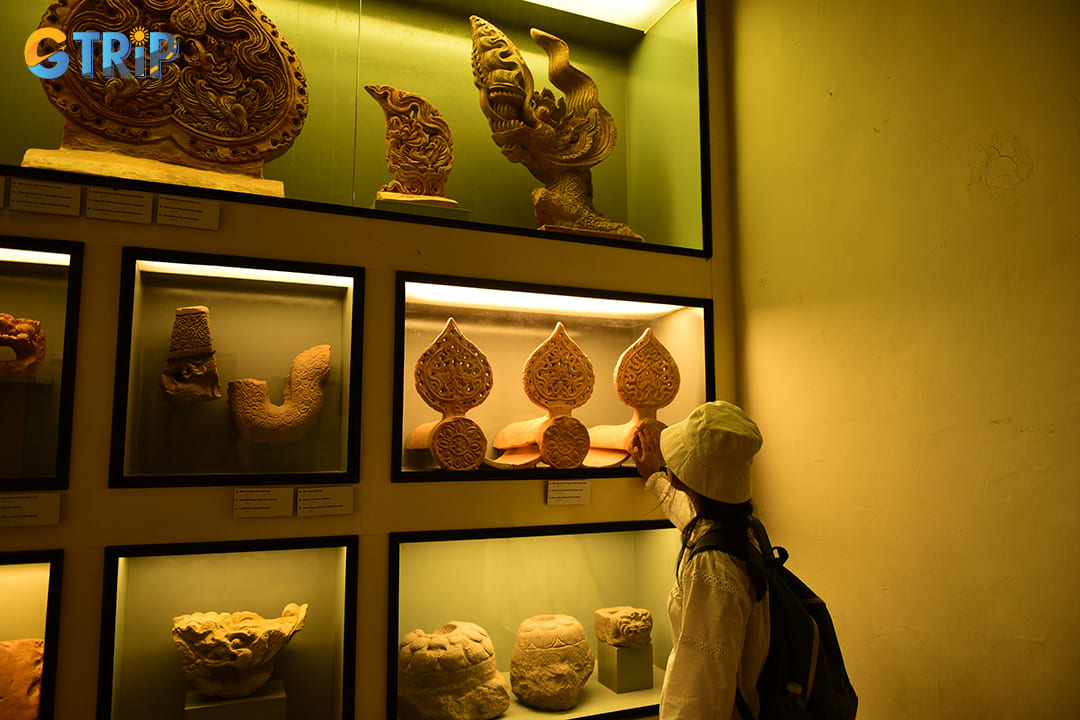
Many of these artifacts are preserved and displayed at the Thang Long Imperial Citadel Heritage Site
"Decoding the Imperial Citadel of Thang Long" night tour
The "Decoding the Imperial Citadel of Thang Long" night tour offers a captivating journey through the heart of Hanoi’s history. Designed to bring the past to life, this 90-minute tour takes place at 7:00 P.M on Friday and Saturday nights, beginning at Doan Mon Gate, the grand entrance to the Forbidden City. This iconic site, once reserved for kings, sets the stage for an evening of cultural discovery. Under the glow of night, visitors are welcomed with mesmerizing royal court performances, reenacting the grandeur of Vietnam’s imperial past.
Beyond the performances, the tour offers an exclusive look at the Imperial Citadel’s archaeological treasures. Guests can explore an exhibition house showcasing relics dating back over a thousand years, providing insight into Vietnam’s dynastic heritage. At Kinh Thien Palace, a solemn incense offering ceremony pays tribute to past emperors, deepening the spiritual connection to this historic site. The journey continues at 18 Hoang Dieu Archaeological Site, where layers of ancient foundations reveal the citadel’s evolution over 1,300 years.
For an interactive twist, you can participate in the “Decoding the Imperial Citadel” game, using laser projections to identify artifacts and uncover historical secrets. This engaging activity allows participants to take home meaningful souvenirs if they successfully complete the challenge. To conclude the evening, guests are invited to enjoy traditional lotus tea and lotus jam beneath a sacred Bodhi tree, a moment of reflection amidst the echoes of history. This tour is an unmissable experience for those seeking a deeper connection with Vietnam’s imperial legacy.
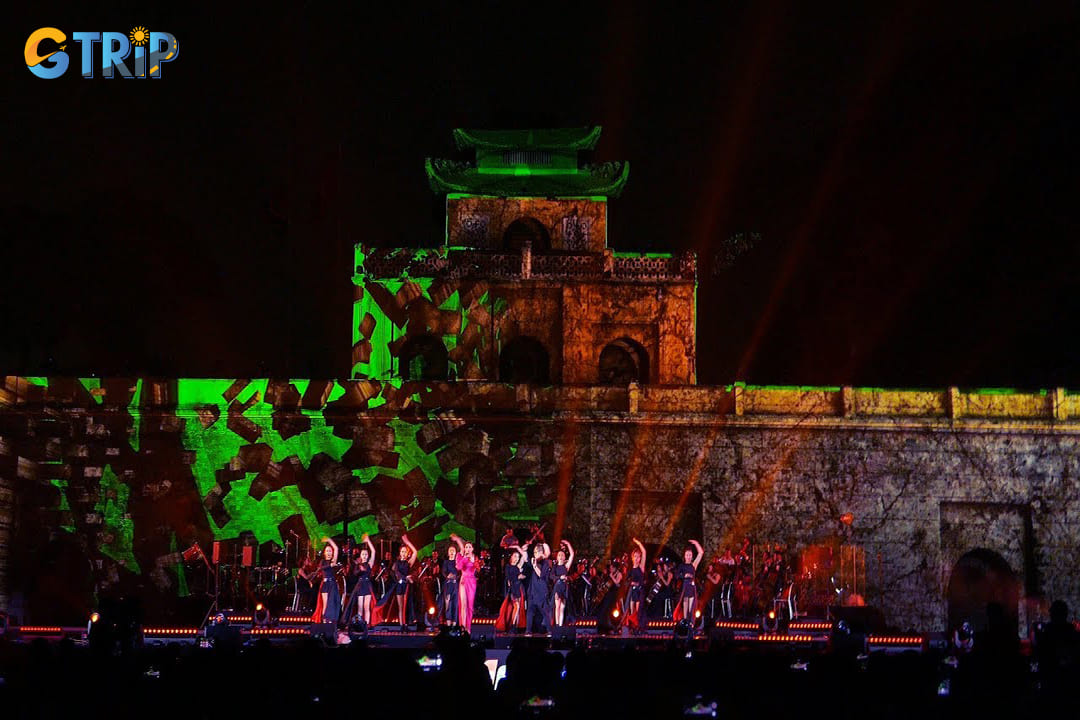
The "Decoding the Imperial Citadel of Thang Long" night tour offers a captivating journey through the heart of Hanoi’s history
Opening hours & entrance fees to visit the Imperial Citadel of Thang Long
Discover the visiting schedule and ticket prices for the Imperial Citadel of Thang Long, including discounts and free admission policies.
Opening hours
The Thang Long Imperial Citadel welcomes visitors daily, offering ample time to explore its historical and architectural wonders. The official visiting hours are as follows:
- Opening time: 8:00 AM
- Closing time: 5:00 PM
- Days of operation: Open every day, including weekends and public holidays.
Entrance fees
| Category | Entrance fee (VND) | Entrance fee (USD) | Eligibility criteria |
|---|---|---|---|
| General admission | 100,000 | ~$4 | All Vietnamese and international visitors |
| 50% Discount (50,000 VND) | 50,000 | ~$2 | - Individuals with severe disabilities - Vietnamese citizens aged 60+ with an Elderly Person Card - Students, trainees, and university students (aged 16+) with valid student IDs issued by institutions under the national education system in Vietnam |
| Free admission | 0 | $0 | - Individuals with exceptionally severe disabilities - Children under 16 years old (with proof such as a birth certificate or student ID) - If no documentation is available, children under 1.3 meters in height |
Note: USD values are approximate and may vary based on exchange rates.
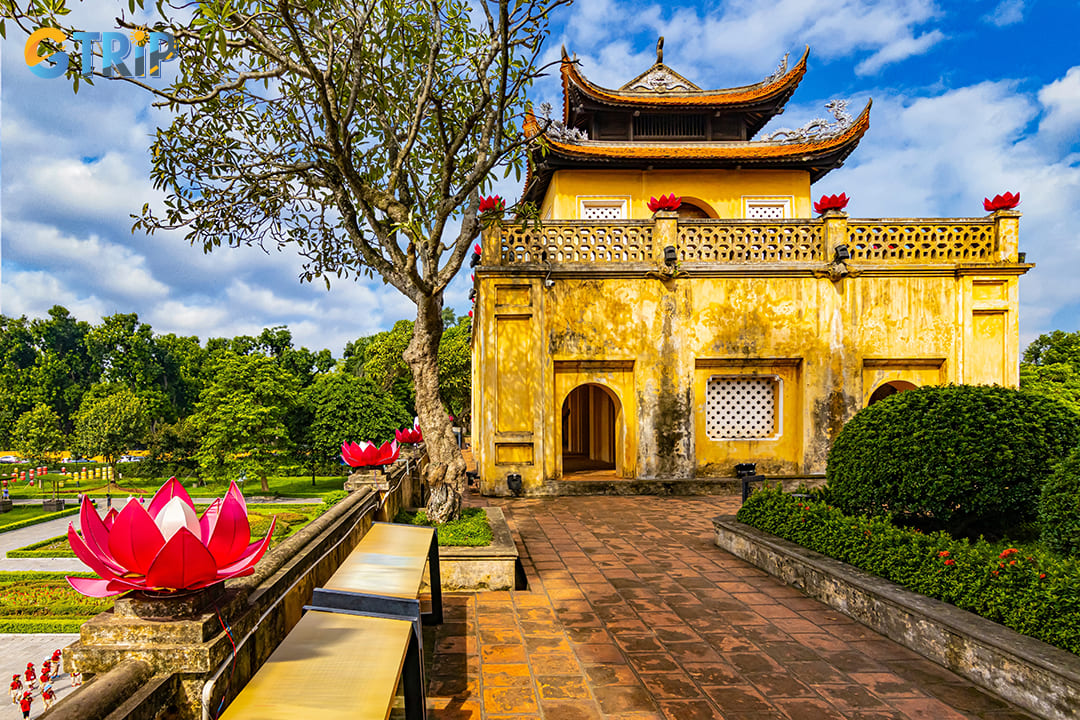
The Thang Long Imperial Citadel welcomes visitors daily, offering ample time to explore its historical and architectural wonders
The best time to visit Thang Long Imperial Citadel
The best time to visit the Thang Long Imperial Citadel is during Hanoi’s dry season, which typically spans from October to April. During this period, the weather is cooler and more comfortable, with average temperatures ranging between 15°C and 25°C (59°F - 77°F). The humidity is lower compared to the summer months, making it ideal for exploring the outdoor ruins, courtyards, and ancient gates without discomfort. In particular, October to November offers a pleasant autumn atmosphere with clear skies. March to April provides a vibrant spring ambiance with blooming flowers, enhancing the historical site's aesthetic appeal. Additionally, visiting in early February allows travelers to experience the Tet Festival (Vietnamese Lunar New Year), which often brings cultural displays and traditional celebrations near historical landmarks like the citadel.
Conversely, the months from May to September bring Hanoi’s hot and humid summer, with temperatures rising above 35°C (95°F) and frequent heavy rains, particularly in July and August. While the site remains open year-round, the combination of intense heat and sudden downpours can make outdoor exploration challenging. However, if visiting during this period, early morning or late afternoon hours are preferable to avoid the midday heat. Travelers looking for a quieter experience may also consider visiting during weekdays, as weekends and public holidays tend to attract larger crowds. Regardless of the season, it is advisable to check the weather forecast and bring essentials like sunscreen, a hat, or an umbrella.
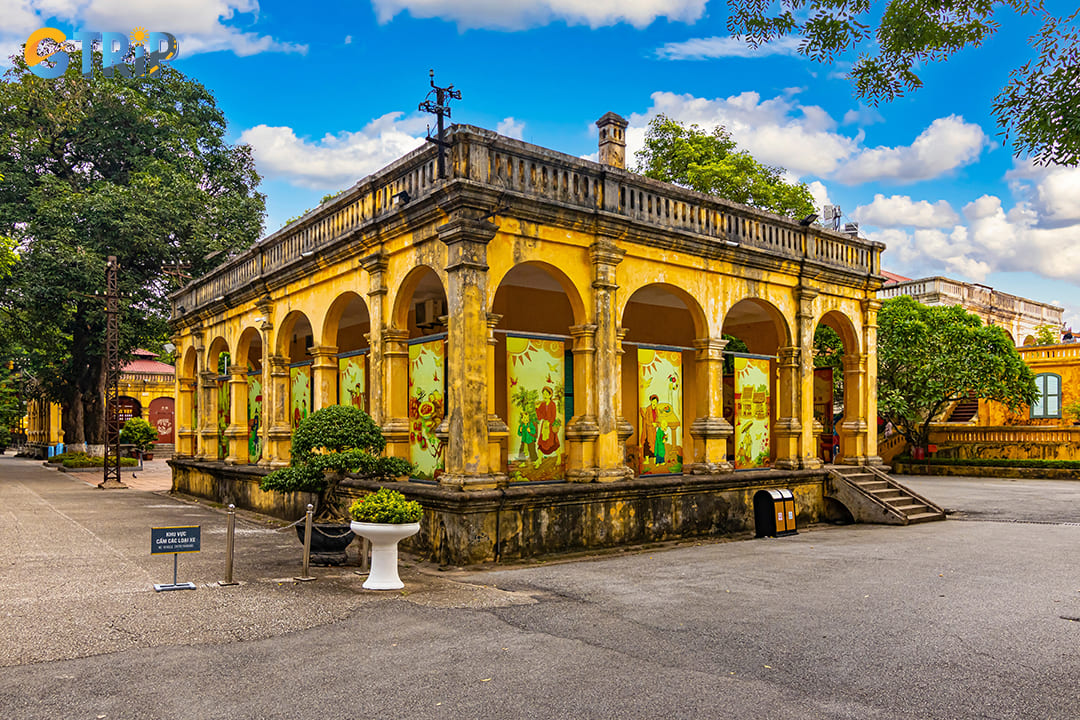
The best time to visit the Thang Long Imperial Citadel is during Hanoi’s dry season, which typically spans from October to April
How to get to Thang Long Imperial Citadel?
There are many ways to reach Thang Long Imperial Citadel that you consider below.
Taxi or ride-hailing services
Taking a taxi or using ride-hailing apps like Grab, Xanh SM (electric taxis), or Be is the fastest and most convenient way to reach the citadel.
- From Hoan Kiem Lake/Old Quarter: 10 - 15 minutes, approx. 30,000 - 50,000 VND ($1.20 - $2.00).
- From Noi Bai International Airport: 35 - 45 minutes, approx. 250,000 - 350,000 VND ($10 - $15).
- From Hanoi Train Station: 5 - 10 minutes, approx. 20,000 - 40,000 VND ($0.80 - $1.60).
Tip: If using a metered taxi, reliable companies include Mai Linh, G7 Taxi, and Taxi Group to avoid scams.
Public bus
For travelers on a budget, Hanoi’s public bus system is a great option, with fares as low as 7,000 VND ($0.30) per ride.
The nearest bus stop is on Hoang Dieu Street, directly in front of the citadel. The following bus routes serve this area:
- Bus 22: Directly stops at Thang Long Imperial Citadel.
- Bus 09, 18, 33, and 45:Stop nearby; requires a short 5-minute walk.
- Bus 34, 41, and 50: Stops at Dien Bien Phu Street, a 7-minute walk to the entrance.
Tip: Use the BusMap Hanoi app for real-time schedules.
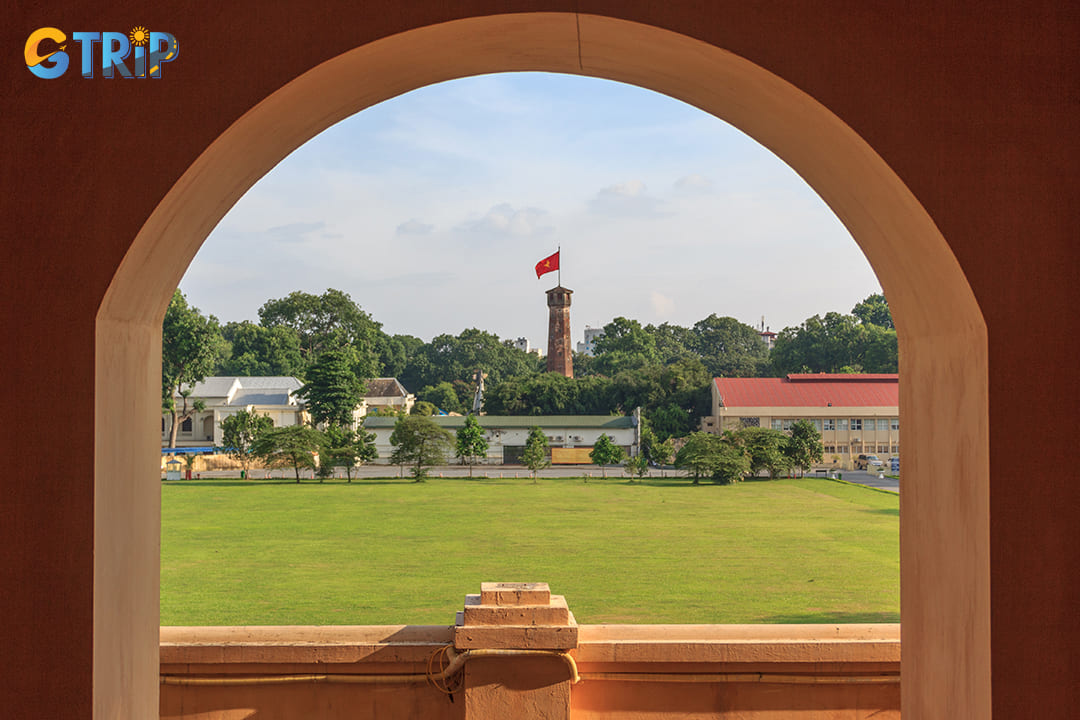
You can reach Thang Long Imperial Citadel by many transportation
Walking or cycling
For tourists staying in the Old Quarter or nearby areas, walking or cycling is a fantastic option. The route offers a chance to explore Hanoi’s charm along the way.
- Walking from Hoan Kiem Lake: 25 - 30 minutes, passing attractions like St. Joseph’s Cathedral and Hanoi Train Street.
- Cycling from Hoan Kiem Lake: 10 - 15 minutes. Many hotels offer bike rentals (50,000:100,000 VND/day).
Tip: Be mindful of Hanoi’s traffic, especially at intersections.
Motorbike rental
Renting a motorbike provides flexibility, especially for those planning to visit multiple sites in one day. Many rental shops in the Old Quarter and near Hoan Kiem Lake offer:
- Daily rental prices: 100,000 - 200,000 VND ($4:$8) depending on the bike model.
- Fuel cost: Around 50,000 VND ($2) for a full tank.
- Parking fee: 5,000 - 10,000 VND ($0.20 - $0.40) near the citadel.
Tip: Always wear a helmet (required by law) and check the bike’s brakes and lights before renting.
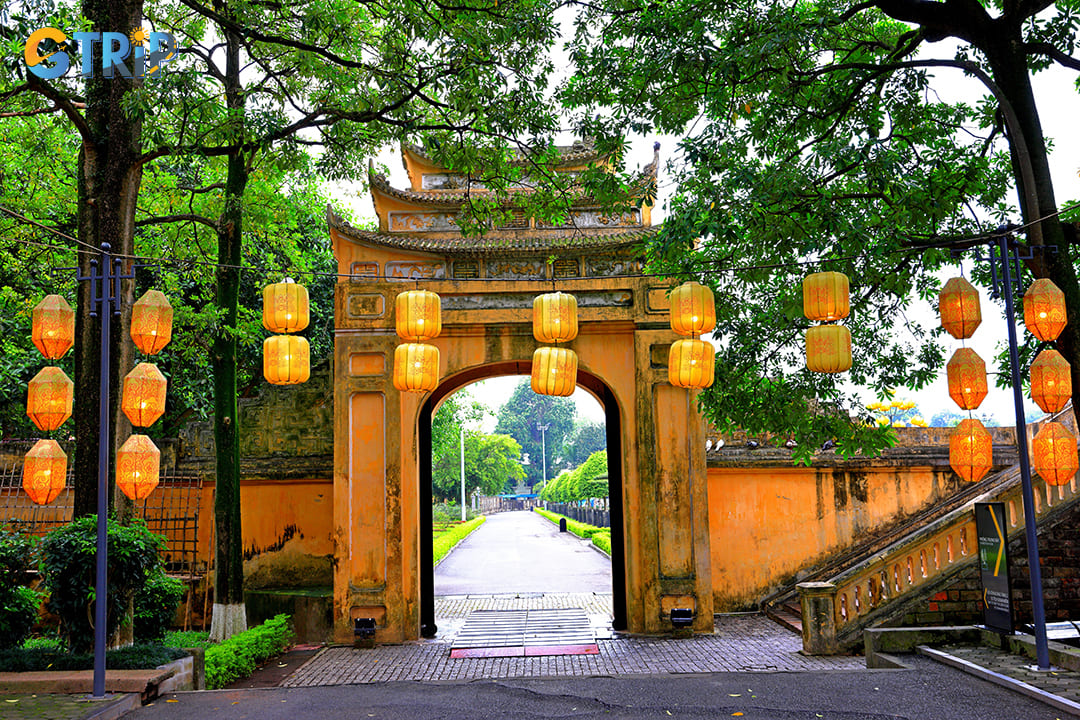
Renting a motorbike provides flexibility, especially for those planning to visit multiple sites in one day
Nearby attractions from Thang Long Imperial Citadel
Tourists to the Thang Long Imperial Citadel often seek to explore more of Hanoi’s rich historical and cultural landscape. Fortunately, several significant landmarks are located within a short distance, making it easy to experience the city’s heritage in a single itinerary. Below are four must-visit attractions near the Imperial Citadel, each offering unique insights into Vietnam’s history, culture, and architecture.
Temple of Literature (1.7 km)
The Temple of Literature (Van Mieu - Quoc Tu Giam) is one of Hanoi’s most revered historical sites, located just 1.7 km from the Thang Long Imperial Citadel. Built in 1070 under Emperor Ly Thanh Tong, this Confucian temple originally served as a place of worship for Confucius and later became Vietnam’s first national university. The complex features five courtyards, tranquil gardens, and 82 stone steles inscribed with the names of scholars who passed the royal examinations between the 15th and 18th centuries.
A visit to the Temple of Literature offers a deeper understanding of Vietnam’s educational traditions and intellectual heritage. The well-preserved traditional Vietnamese architecture, including its red-roofed pavilions, ancient walls, and lotus-filled ponds, provides a serene contrast to the bustling city outside. The temple remains a popular site for students who visit to pray for academic success before important exams.
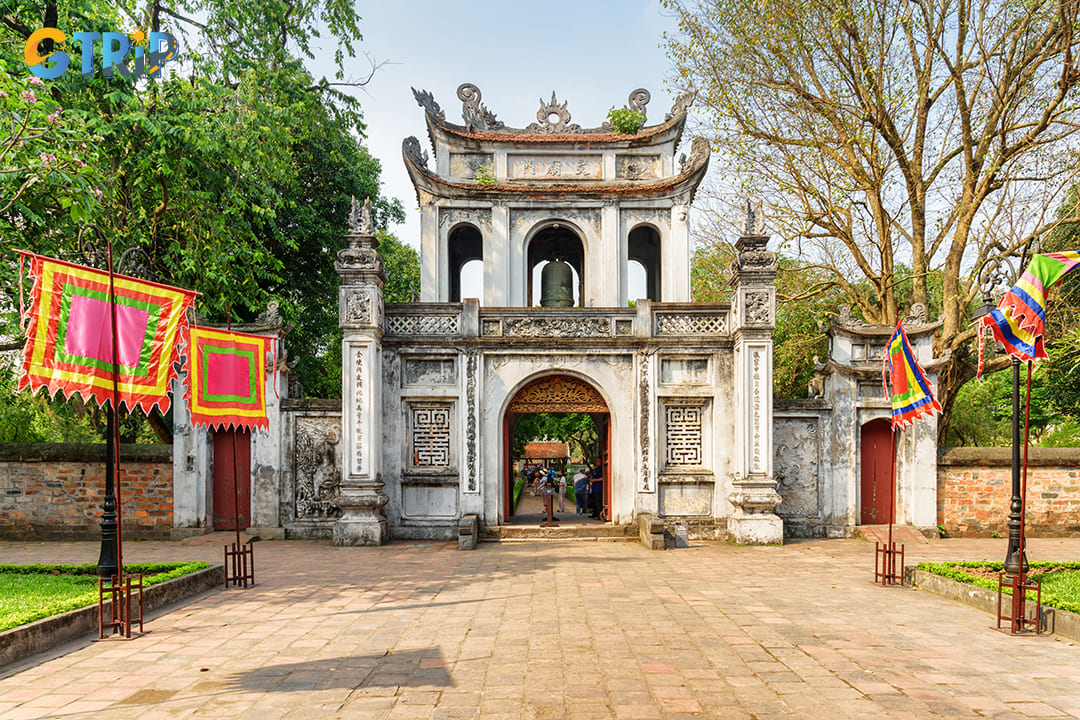
The Temple of Literature (Van Mieu - Quoc Tu Giam) is one of Hanoi’s most revered historical sites
Hanoi Old Quarter (2 km)
Located 2 km east of the Thang Long Imperial Citadel, the Hanoi Old Quarter is the city’s most vibrant and historic district. This area, which dates back over 1,000 years, was originally the commercial hub of the capital, with 36 streets named after the goods traditionally sold there. For example, Hang Bac (Silver Street), Hang Gai (Silk Street), and Hang Dao (Peach Blossom Street).
Walking through the Old Quarter is like stepping back in time, with its narrow streets, colonial-era shophouses, and centuries-old temples. The district is famous for its street food scene, where you can sample Hanoi’s culinary specialties such as pho, bun cha (grilled pork with noodles), and banh mi. In addition to its cultural and gastronomic appeal, the Old Quarter is home to significant landmarks like Bach Ma Temple and the iconic Hoan Kiem Lake.
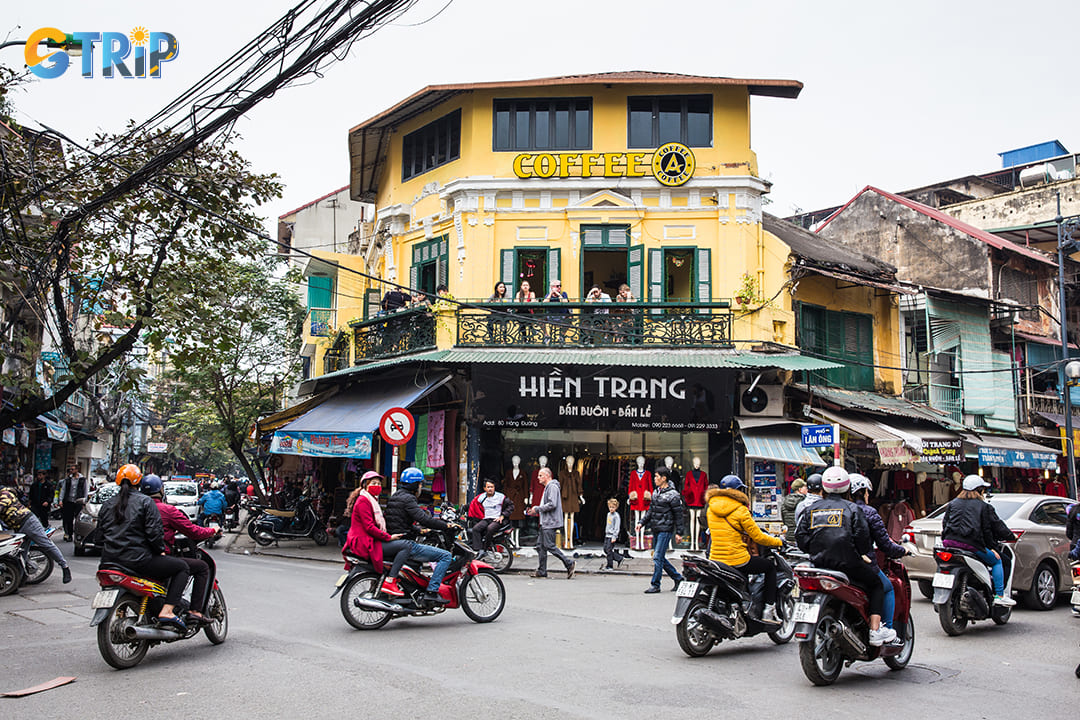
The Hanoi Old Quarter is the city’s most vibrant and historic district
Ho Chi Minh’s Mausoleum (1 km)
Situated just 1 km from the Imperial Citadel, Ho Chi Minh’s Mausoleum is one of the most important political and historical sites in Vietnam. This grand, marble and granite structure, inspired by Lenin’s Mausoleum in Moscow, houses the embalmed body of Ho Chi Minh, the revolutionary leader who played a crucial role in Vietnam’s independence movement.
The mausoleum is part of a larger Ba Dinh Square complex, which includes the Presidential Palace, Ho Chi Minh’s Stilt House, and the Ho Chi Minh Museum. The site attracts both domestic and international tourists who come to pay their respects to “Uncle Ho” and learn about his contributions to Vietnam’s modern history. You should note that strict dress codes and behavioral rules apply, as this is a solemn place of national significance.
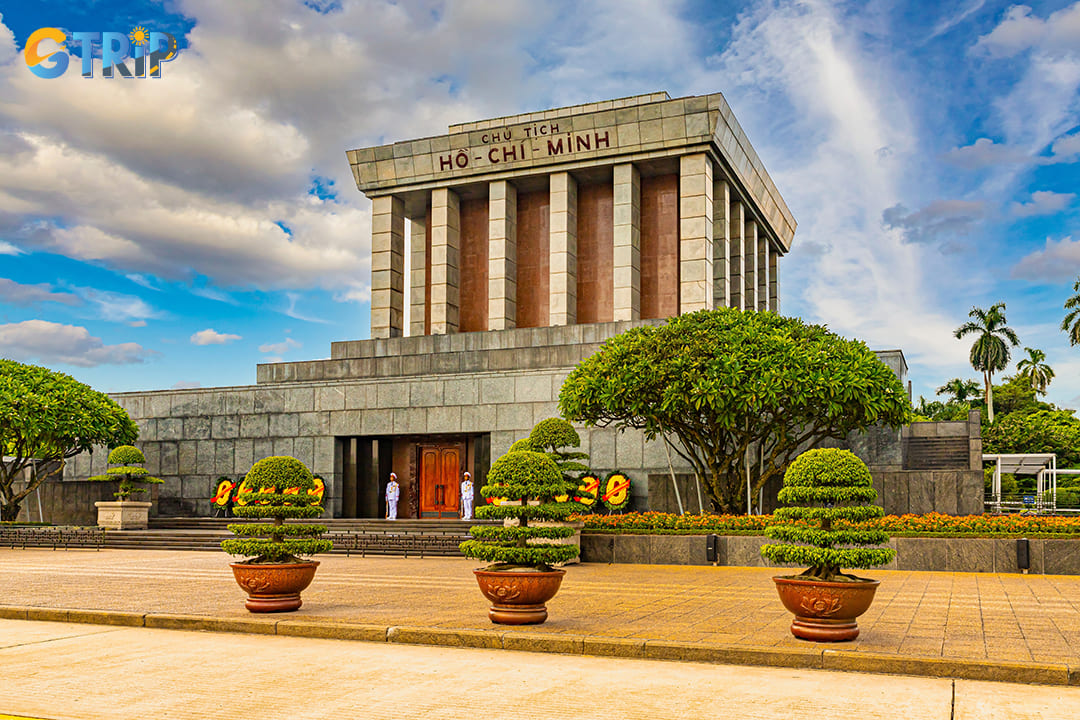
Ho Chi Minh’s Mausoleum is one of the most important political and historical sites in Vietnam
Hoa Lo Prison (1.6 km)
Located 1.6 km from the Thang Long Imperial Citadel, Hoa Lo Prison, often called the “Maison Centrale”, is one of the most haunting historical landmarks in the city. Originally built by the French in 1896, the prison was used to detain Vietnamese political prisoners during the colonial era. Later, during the Vietnam War, it gained international notoriety for housing captured American pilots, including John McCain.
Today, Hoa Lo Prison has been transformed into a museum, offering a sobering look at Vietnam’s struggle for independence. Exhibits include prison cells, torture instruments, and firsthand accounts from former detainees. The museum provides a stark contrast to Hanoi’s other historical sites, emphasizing the resilience and sacrifices of those who fought for Vietnam’s freedom.
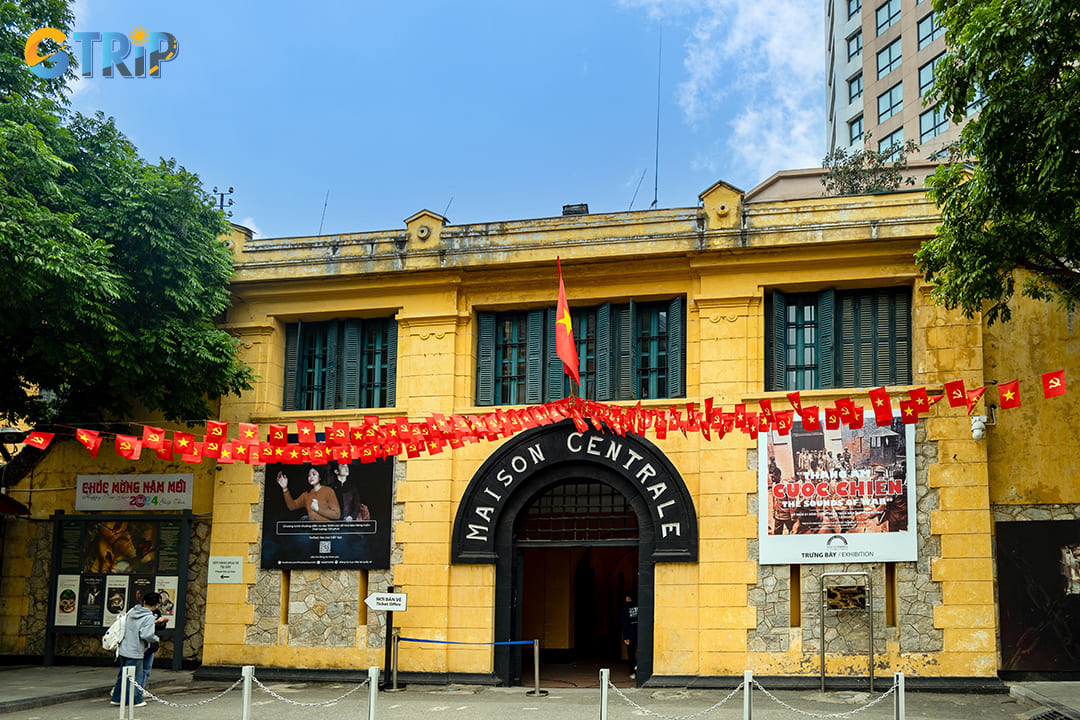
Hoa Lo Prison is one of the most haunting historical landmarks in the city
Travel tips when visiting Thang Long Imperial Citadel
- Follow security instructions: Some sections may be restricted for restoration work; always follow designated paths.
- Respect the quiet atmosphere: The citadel is a place of reflection and history, so keep noise levels low.
- Wear comfortable footwear: The citadel covers a large area with uneven surfaces, so wear comfortable walking shoes.
- Respect cultural and historical significance: Follow preservation rules, avoid touching artifacts, and dress modestly to respect the site's heritage.
- Take a guided tour: A professional guide or audio tour will provide deeper insights into the history and significance of the citadel.
- Bring a power bank: If you're taking many photos or using an audio guide app, a power bank will be useful.
- Bring sun protection & water: Hanoi’s weather can be hot and humid, so pack sunscreen, a hat, and a bottle of water.
- Read about Vietnamese history before visiting: Understanding the site's historical context will enhance your appreciation of the citadel’s significance.
- Plan extra time for the Hoang Dieu Archaeological Site: This excavation site reveals fascinating remnants of ancient Thang Long.
- Capture the Hanoi Flag Tower at sunset: One of the most photogenic spots, best photographed in the golden hour.
- Look for special exhibitions: The citadel often hosts cultural and historical exhibitions showcasing ancient artifacts and documents.
- Visit during festivals or national holidays: If possible, plan your visit during Tet or other celebrations to witness special events and performances.
- Be mindful of photography restrictions: Some areas may prohibit flash photography or filming, always check for signs.
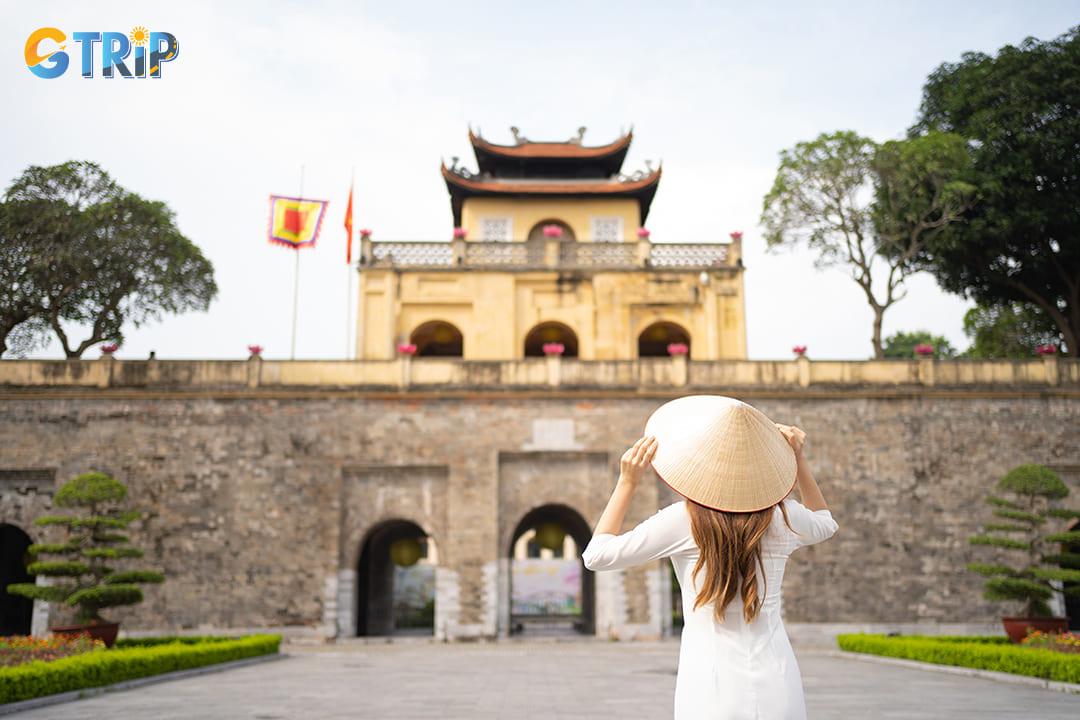
The citadel is a place of reflection and history, so keep noise levels low
Frequently Asked Questions (FAQs) about Thang Long Imperial Citadel
Is photography allowed inside the citadel?
Yes, photography is allowed in most areas of the Thang Long Imperial Citadel. However, there are some restrictions in certain exhibition halls or areas with fragile artifacts. For professional photography or filming, you may need to obtain special permission from the management board.
Is the Thang Long Imperial Citadel wheelchair accessible?
While parts of the citadel are wheelchair accessible, some areas, such as the Dragon Steps at Kinh Thien Palace, may be difficult to navigate due to their ancient design. However, the main paths and exhibition halls are accessible. It's recommended to check with the ticket counter for assistance.
Can I see the original imperial palaces at the citadel?
Unfortunately, most of the original wooden palaces were destroyed over time due to wars and natural decay. However, you can still see stone foundations, reconstructed gateways, and relics that indicate the grandeur of the ancient capital. The Kinh Thien Palace platform and dragon steps are some of the best-preserved imperial remnants.
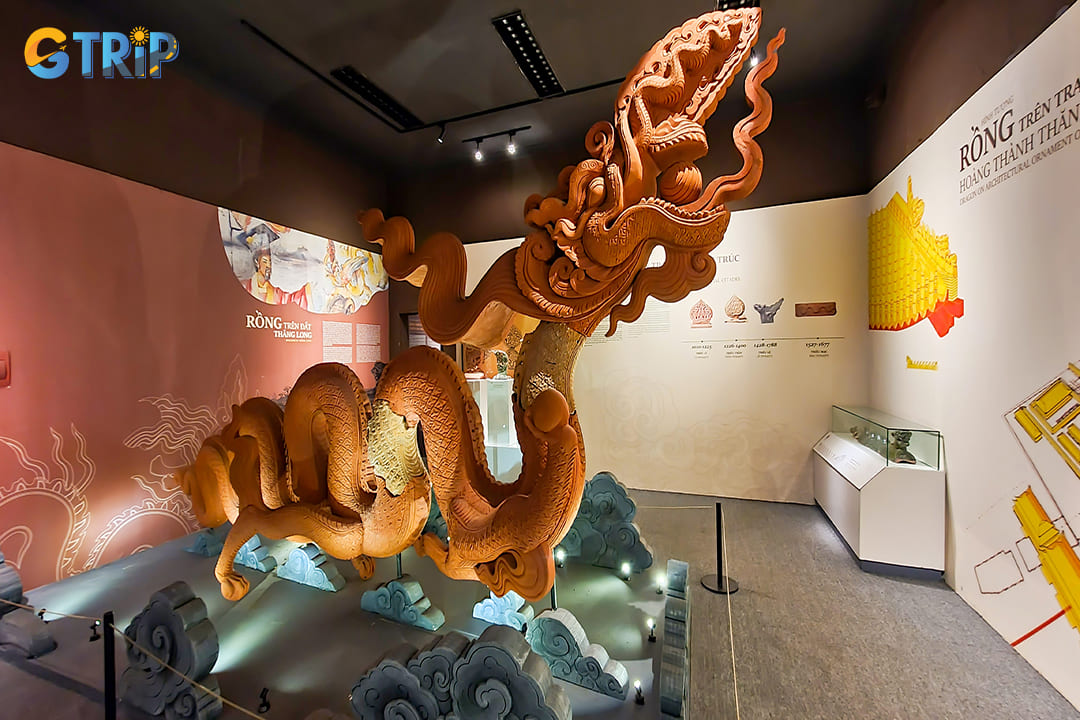
You can still see stone foundations, reconstructed gateways, and relics that indicate the grandeur of the ancient capital
The Thang Long Imperial Citadel stands as a testament to Vietnam’s rich history, offering a glimpse into the country’s dynastic past, military strategy, and cultural evolution. Through this deep dive, we've explored its architectural significance, archaeological discoveries, and the vital role it played in shaping Hanoi as the capital. For travelers, history enthusiasts, and cultural explorers, visiting the citadel is a journey through centuries of resilience and legacy. To make the most of your visit, consider planning your itinerary around key historical highlights or pairing it with other nearby landmarks like the Ho Chi Minh Mausoleum. If you're eager to learn more about Hanoi’s imperial past, check out GTrip in-depth guides on Vietnam’s other UNESCO sites.

